We explore Mesoamerican civilizations and explain their characteristics. In addition, we discuss the most prominent cultures and the contributions they made.
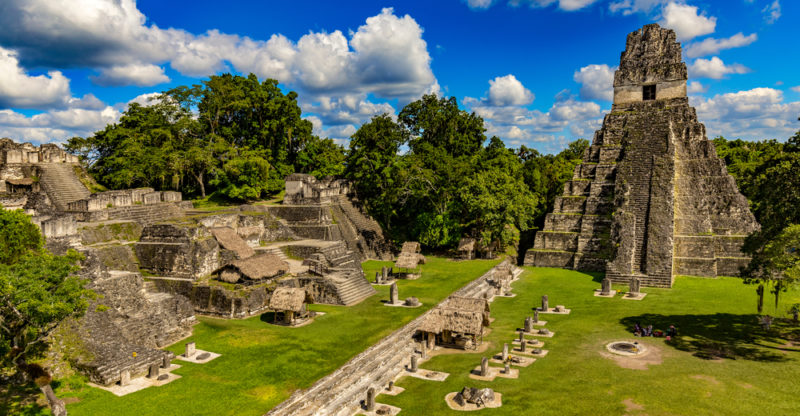
What are Mesoamerican civilizations?
Mesoamerican civilizations are societies that inhabited the central region of the American continent between 2500 BC and 1521 AD.
The name Mesoamerica comes from Greek meaning "middle" or "intermediate", and makes reference to the lands of Central America. In this region, various cultures flourished for four millennia until the arrival of the Spanish in America. Therefore, they are also known as "pre-Columbian cultures" or "indigenous peoples" along with the rest of American cultures.
Mesoamerican civilizations had varying degrees of social and political complexity. Some peoples were nomadic, leaving few traces of their existence. However, most Mesoamerican societies engaged in agriculture, settled in villages and cities, had a stratified political organization, and developed an economy that was interconnected through trade networks with other peoples in the region.
Mesoamerican societies include the Olmecs, the Maya, and the Aztecs, notable for their cultural and architectural development.
- See also: Spanish democracy
What were Mesoamerican civilizations?
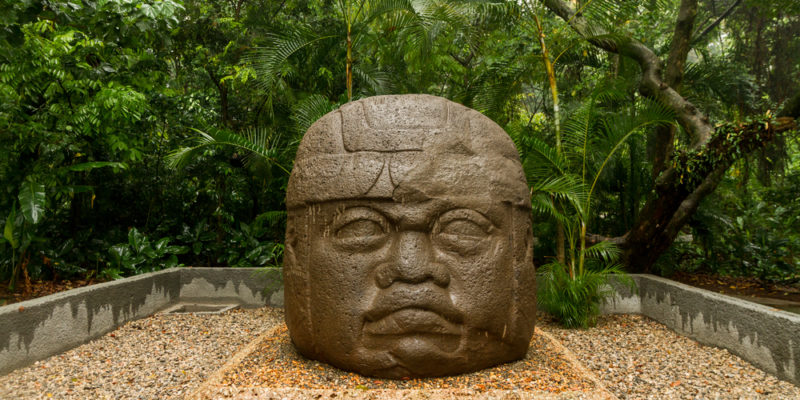
The most prominent Mesoamerican cultures were:
- Olmecs (1500 BC-400 BC). They were the earliest major civilization in the region. The Olmecs were noted for the development of agriculture, the settlement in cities with ceremonial centers, the construction of monumental sculptures, the invention of the calendar, and the development of a writing system.
- Zapotecs (500 BC-900 AD). They settled in the south of present-day Mexico and had a complex and stratified political organization, in which the majority of the population paid tributes to a privileged minority with government and religious ties.
- Maya (2000 BC-1540 AD). They occupied the Yucatán peninsula for three millennia and developed extensive knowledge in mathematics, astronomy, and writing. The Maya civilization had a complex political and social organization, with a pyramidal hierarchy governed by a politico-religious caste.
- Teotihuacanos (150 BC-1150 AD). They developed sophisticated techniques in art. Teotihuacan pottery featured geometric paintings and images of gods, which also appeared as decoration on large constructions.
- Mixtecs (1500 BC-1523 AD). They reached their height between 950 AD and 1521 AD, with a large number of city-states under their dominion. The Mixtec culture was known for the development of war technology and a complex social organization where noble women could participate in the higher spheres of power.
- Aztecs or Mexica (1325 AD-1521 AD). They founded the city of Mexico-Tenochtitlan, present-day Mexico City. The Aztecs were a warlike civilization that managed to conquer their neighbors and develop an imperial state. They built large cities, with palaces, temples, and markets.
- Toltecs (650 AD-1150 AD). They reached their splendor between 900 AD and 1100 AD, founding a city-state of militaristic ideology. The Toltecs engaged in trade and used cocoa beans as currency. Their architectural and artistic style influenced contemporary cultures.
Historical periods of Mesoamerican civilizations
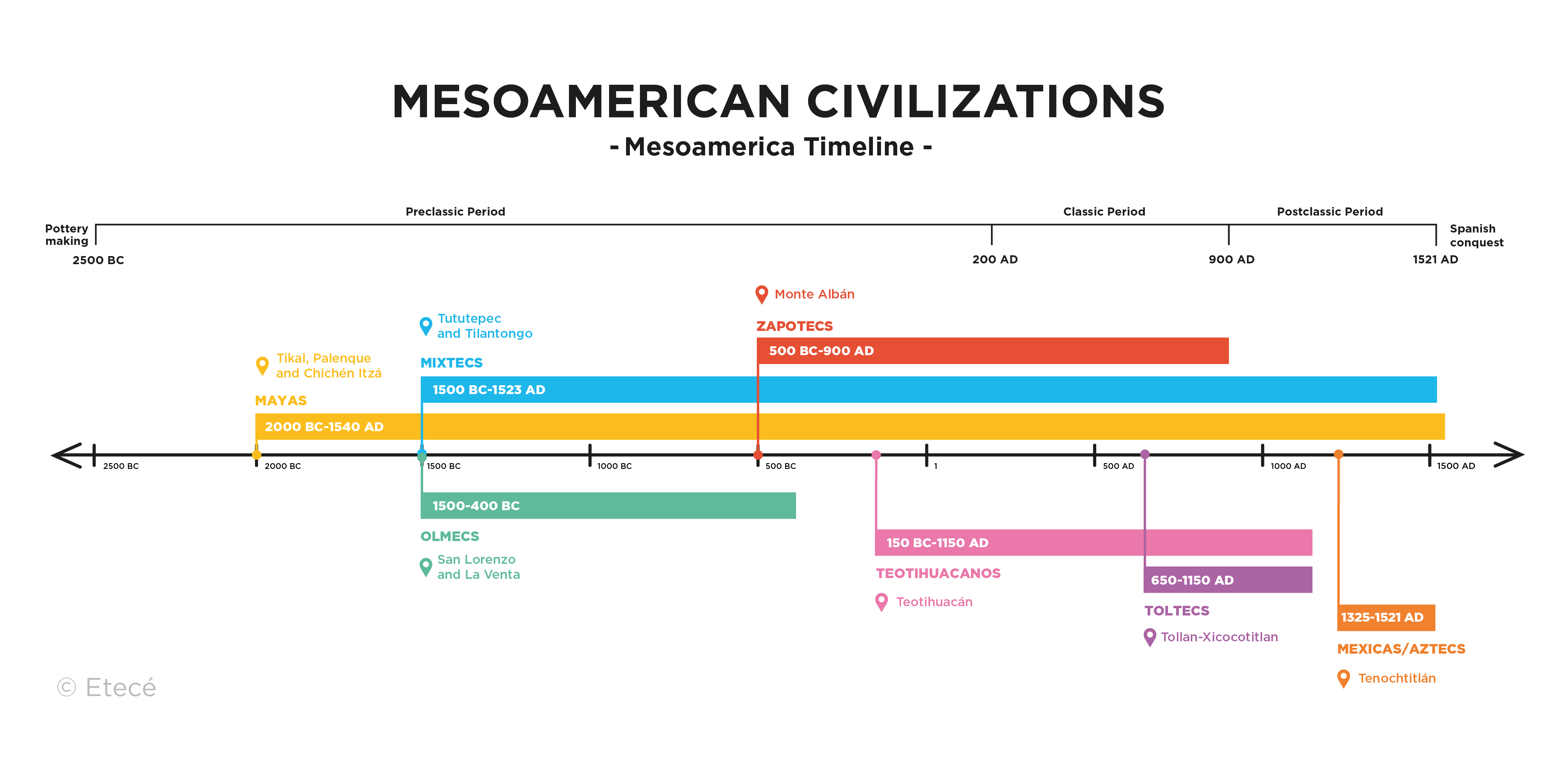
Preclassic (2500 BC-200 AD)
This period witnessed the origins of agricultural settlements and pottery production. Preclassic Mesoamerica was marked by a steady population growth, the development of agricultural techniques and water control systems. With the rise of villages, needs diversified, leading to the specialization of labor.
Throughout the Preclassic era, the exchange of goods among the different peoples flourished, leading to the establishment of extensive trade routes that spanned the region. In addition, this period was characterized by stone carving, ranging from polished jade to monumental construction and sculpture.
By the end of the Preclassic period, several Mesoamerican cultures had developed calendars and complex writing systems that were later used by societies in subsequent periods.
The most prominent cultures of this period were the Olmecs, the Tlatilco culture, and the Mixtecs.
Classic (200 AD-900 AD)
During this period, the distinction between rural and urban settings within Mesoamerican societies took place. Some villages transformed into urban centers, where crafts, political, religious and administrative activities were concentrated, while the surrounding farmlands provided most agricultural products for subsistence. In addition, this period saw a leap in population growth and density, linked to the development of intensive agricultural techniques and soil use.
Social differentiation and the specialization of labor deepened. Elites consolidated in government activities, exerting political as well as ideological dominance over the rest of the population. Furthermore, religion began to play a structural role as ideological and moral authority in social organization.
The exchange of goods evolved to create complex long-distance trade networks, which influenced the political and economic evolution of the different cultures in the region. Polities associated with major urban centers boasting massive architectural complexes and distinct artistic styles emerged. Against this backdrop, wars were waged between the various powers over sovereignty and the control of goods.
Culturally, this period reached its height with the invention of the calendar, the writing and numbering systems, the rise of astronomy and a flourishing in the arts. In religion, a pantheon of gods common to all Mesoamerican beliefs consolidated.
The main cultures during this period were the Zapotecs, Teotihuacanos, Mixtecs, and Maya.
Postclassic (900 AD-1521 AD)
This period was marked by political instability and constant warfare between Mesoamerican cultures. Postclassic Mesoamerica witnessed the sudden rise and fall of aggressive states seeking to conquer neighboring societies. In turn, the military and geographic expansion of the states that emerged victorious resulted in the imposition of tribute on the defeated peoples.
In this regard, defensive architecture was developed in urban centers, as well as new forms of religious worship linked to warfare and political sovereignty. Human sacrifice appeared in religious ceremonies, and art motifs evolved to depict war, sacrifices, and death.
The end of the period is marked by the Spanish conquest of the Mexica empire in 1521, although some Mesoamerican areas remained free from European domination until the late 17th century.
The principal cultures during this period were the Totonacs, Mixtecs, Toltecs, and Mexicas.
Geographic location of Mesoamerican civilizations
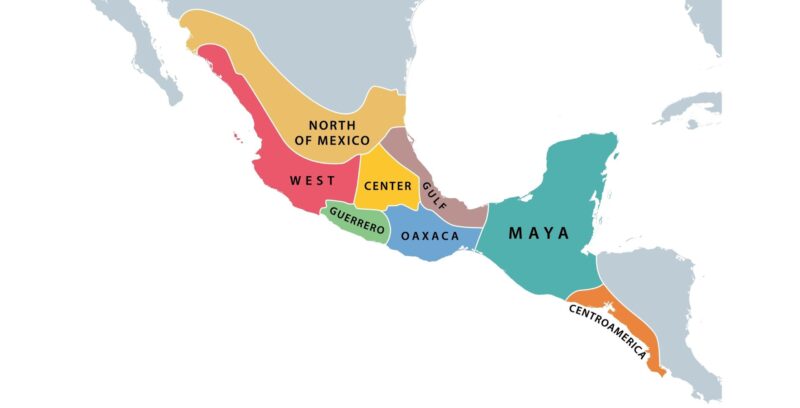
Mesoamerican civilizations inhabited the central region of the American continent, bounded by the Pacific Ocean to the west, and the Caribbean Sea and the Gulf of Mexico to the north and east. Today, this area encompasses present-day Mexico, Guatemala, El Salvador, Honduras, Belize, Nicaragua, and Costa Rica.
Various regions can be identified in Mesoamerica based on their climate, geographic features, and history: Northern Mesoamerica, Gulf Coast, Maya Region, Oaxaca, Central Highlands, and Western Mesoamerica.
Characteristics of Mesoamerican civilizations

Mesoamerican civilizations shared the following common features:
- Agriculture. The development of agriculture and the evolution of production techniques during the three periods was a common feature of Mesoamerican societies. Main crops included corn, chili peppers, beans, pumpkins, vegetables, and cacao, constituting the basic diet of the population. To this end, they created systems for water control and storage, goods transportation, and resource storage.
- Government. Many of these civilizations had organized, hierarchical systems of government. Power was often hereditary and held by priestly castes and aristocratic families who maintained their status through ideological domination and control over resource and wealth distribution.
- Trade. The trade of utilitarian items and luxury goods enabled regular contact among Mesoamerican civilizations, allowing them to share customs, practices, and knowledge. Trade also spurred societies' internal growth and served as a means to impose cultural and social dominance.
- Military organization. Warfare was a fundamental feature of Mesoamerican cultures. Warriors held a privileged position and were revered by the rest of the population. Some civilizations subdued other peoples militarily, forcing them to pay tributes and taxes.
- Religion. All Mesoamerican cultures were polytheistic. They believed in the existence of multiple gods, though in some cases one predominated over the rest. Many deities were linked to the natural elements and beings, like water, fire, earth, the feathered serpent, and the jaguar, while other gods were related to human activities such as agriculture, trade, or war.
- Culture. Although each civilization developed its own cultural identity, Mesoamerican societies shared cultural traits throughout the three periods. There are common elements in the sculptural and architectural styles of Mesoamerican civilizations, with religious beliefs heavily influencing artistic imagery.
What language was spoken in Mesoamerica?
The origins of Mesoamerican peoples were highly diverse, arriving in the region at different periods and speaking various languages. Experts believe that Mesoamerican languages and dialects can be grouped into 16 families. The most prominent languages include Nahuatl (Uto-Aztecan family), Zapotec and Mixtec (Oaxacan family), and those in the Mayan linguistic family, many of which persist today.
The Olmec, Zapotec, Mixtec, Maya, and Aztec cultures developed their own writing systems, some of which remain partly undeciphered. The Maya and Aztec civilizations created a logographic writing system in which signs functioned as letters, were designated by sounds and syllables, and combined to form words.
Contributions of Mesoamerican civilizations
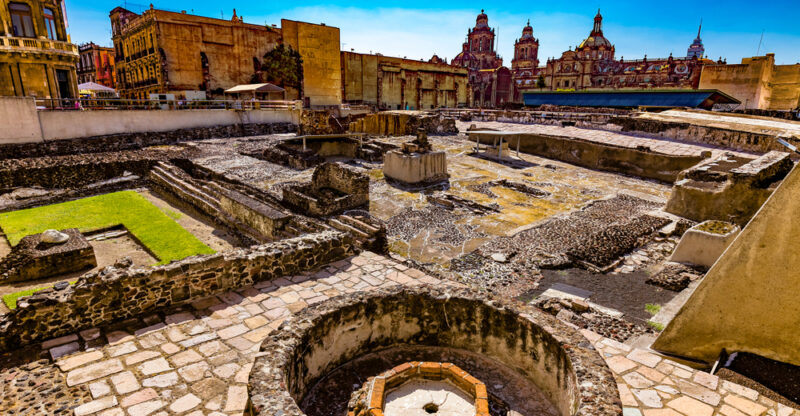
Significant contributions of Mesoamerican cultures include:
- Writing system. The first to create a writing system in America were the Olmecs. Most scripts were based on glyphs (symbols) representing ideas or words, though it is believed that some may have represented syllables or phonemes.
- Calendar. The Olmecs devised the sacred 260-day lunar calendar and the 365-day solar calendar to mark agricultural cycles. Both were used and perfected by other Mesoamerican cultures through advances in astrology and nature observation.
- Architecture. Mathematical knowledge and the development of complex construction techniques allowed Mesoamerican civilizations to transform villages into urban centers with ceremonial buildings and monumental structures.
- Pyramids. Architectural mastery reached its height with the pyramids, which served as political, ceremonial and religious centers.
References
- López Austin, Alfredo; y López Luján, Leonardo (2001): El pasado indígena. México DF: El Colegio de México.
- Boehm de Lameiras, B. (1991). El Estado en Mesoamérica. Estudio sobre su ongen y evolución. Revista Española de Antropología Americana, 21, 11.
- Carmack, Robert et. al. (1996): The legacy of Mesoamérica: history and culture of a Native American civilization. Prentice Hall. Nueva Jersey.
- Duverger, Christian (1999): Mesoamérica, arte y antropología. CONACULTA-Landucci Editores. París.
Explore next:
Was this information useful to you?
Yes NoThank you for visiting us :)